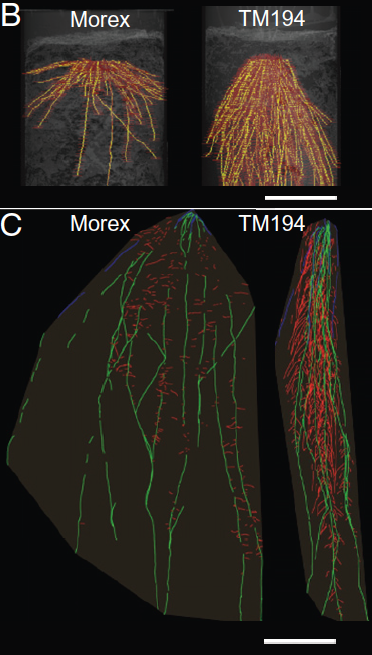
Root angle is controlled by EGT1 in cereal crops employing a novel anti-gravitropic mechanism.
Authors
Fusi et al (33 coauthors, including JP Lynch)
Source
PNAS 119 (31) e2201350119
Download Options
Abstract
Root angle in crops represents a key trait for efficient capture of soil resources. Root angle is determined by competing gravitropic versus anti-gravitropic offset (AGO) mechanisms. Here we report a new root angle regulatory gene termed ENHANCED GRAVITROPISM1 (EGT1) that encodes a putative AGO component, whose loss of function enhances root gravitropism. Mutations in barley and wheat EGT1 genes confer a striking root phenotype, where every root class adopts a steeper growth angle. EGT1 encodes a F-box and Tubby domain containing protein which is highly conserved across plant species. Haplotype analysis found that natural allelic variation at the barley EGT1 locus impacts root angle. Gravitropic assays indicated that Hvegt1 roots bend more rapidly than wildtype. Transcript profiling revealed Hvegt1 roots deregulate ROS homeostasis and cell wall-loosening enzymes and cofactors. ROS imaging revealed Hvegt1 root elongation zone tissues have reduced levels. Atomic Force Microscopy measurements detected elongating Hvegt1 root cortical cell walls are significantly less stiff than wildtype. In situ analysis identified HvEGT1 is most highly expressed in elongating cortical and stele tissues, which are distinct from known root gravitropic perception and response tissues in the columella and epidermis, respectively. We propose that EGT1 controls root angle by regulating cell wall stiffness in elongating root cortical tissue, counteracting the gravitropic machinery’s known ability to bend the root via its outermost tissues. We conclude that root angle is controlled by EGT1 in cereal crops employing a novel anti-gravitropic mechanism.

